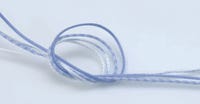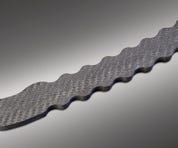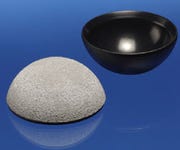June 1, 2011
 ePTFE materials
ePTFE materials
Used to manufacture AAA and coronary stent coverings, orthopedic implant coverings, and cardiovascular and urological implant components, an ePTFE material from Bard Peripheral Vascular OEM Products is chemically inert, hydrophobic, and gas permeable. Available in a range of tubular diameters, lengths, and wall thicknesses, the material is suitable for a variety of implantable medical device applications, including coronary artery bypass graft devices, septal defect devices, LVAD cannulae components, vascular grafts, AV access devices, urethral slings, and penile implant components. In addition to displaying conformability, temperature stability, and gas permeability, the ePTFE material can be made thin and strong using the company's high-density microwall technology. This process can produce flat sheets with thicknesses as low as 0.1 mm.
Bard Peripheral Vascular OEM Products
TEMPE, AZ
www.bardpvoem.com
 Tissue-growth scaffold material
Tissue-growth scaffold material
A provider of biomedical textiles specializes in biomaterial knitting, braiding, weaving, and nonwoven technology, including the Biofelt nonwoven biocompatible tissue-growth scaffold material. Offering biomaterials for use in tissue engineering and regenerative medicine, Biomedical Structures provides products that support natural cell growth for repairing or replacing damaged tissue in cardiovascular, urological, and other applications. The supplier also produces a variety of other absorbable and nonabsorbable biomaterials for implantable devices, drug-delivery technologies, and other applications in orthopedics, general surgery, tissue engineering, cardiology, bariatrics, and cosmetic surgery. Its full service range comprises design, development, compliance and validation, biomaterials testing, prototyping, and full-scale production.
Biomedical Structures
WARWICK, RI
www.bmsri.com Implantable-grade fiber
Implantable-grade fiber
Dyneema Purity ultrahigh-molecular-weight polyethylene (UHMWPE) fiber is designed for use inside the body during surgery or over the longer-term lifespan of an implant. Available in white or blue designs from DSM, this 100%-colored implantable-grade UHMWPE fiber offers surgeons the benefit of contrast and differentiation by helping to address confusion of multiple suture strands. Fifteen times stronger than cable steel, the fiber is hydrophobic, hemocompatible, biocompatible, soft, and pliable. Its near-zero stretch enhances fixation in such orthopedic applications as knee and shoulder arthroscopy. The fiber's resistance to fatigue and abrasion is advantageous in cardiovascular applications that require thin structures, lowering the risk of complications resulting from internal or external stressors. Textile companies use a variety of techniques--such as fiber knitting, braiding, and weaving--to process the UHMWPE fiber into medical devices. Recently, it has been used in an endoscopy nitinol clip system and in a durable surgical mesh application. The fiber has been through extensive biocompatibility testing and has a Master File on record with FDA.
DSM
BERKELEY, CA
www.dsmbiomedical.com
Carbon-fiber composites
Exhibiting mechanical strength and heat-distortion properties, Tecatec-series thermoplastic carbon-fiber composites from Ensinger Inc. consist of a thermoplastic matrix and a woven fabric made of carbon-fiber bundles. This combination, according to their manufacturer, provides higher tensile and flexural strength than fiber-reinforced extrudates. Supplied in standard plate thicknesses of 3 to 40 mm and in other dimensions upon request, the lightweight, chemical-resistant materials are also radiolucent, making them suitable for external fixation devices and surgical instruments. One of the composites--a PEEK-matrix polymer compressed with laminated woven-carbon fabric mats constituting 50% of the composite--provides torsional stiffness and resists warping even after multiple sterilization cycles. The other composite is a PEKK matrix laminated with a 60%-carbon-fiber fabric. Capable of undergoing steam sterilization, this carbon-fiber component ensures dimensional stability and stiffness.
Ensinger Inc.
WASHINGTON, PA
www.ensinger.co.uk Joint-replacement polymer
Joint-replacement polymer
Developed by Invibio Biomaterial Solutions for use in joint arthroplasty, Motis reinforced PEEK-based polymer exhibits resistance to wear, induces a limited biological response to wear debris, and features mechanical properties that qualify it as a potential replacement for metal, ceramic, and polyethylene components. Capable of addressing clinical concerns surrounding metal-on-metal bearing surfaces, the material features a stiffness that provides a better anatomical load distribution than metals, according to its manufacturer. Its strength, creep, and fatigue performance have enabled it to be used as a thin cup in a large ceramic head system, enhancing bone conservation. To optimize fixation, the biomaterial can be coated with porous titanium or hydroxyapatite. In addition, it can be injection molded without compromising precision or surface characteristics, and the near-net shapes it can produce help accelerate device development.
Invibio Biomaterial Solutions
WEST CONSHOHOCKEN, PA
www.invibio.com Biomedical textiles
Biomedical textiles
Featuring complex fabric geometries and distinct fiber architectures, biomedical textiles supplied by Secant Medical support engineers in designing next-generation orthopedic devices. Produced using traditional fabric-forming technologies, these textiles are constructed from high-performance polymeric, metallic, and hybrid resorbable biomaterials. They offer design versatility for soft-tissue fixation and anchoring devices and are also suited for applications involving high static or dynamic loads, such as long-bone fixation, spinal stabilization, tendon repair, and ligament replacement. Hybrid resorbable polymeric textile composites can be engineered for structural degradation or temporary biomechanical reinforcement. They can also serve as temporary 3-D scaffold matrices capable of functioning as ordered-growth environments for orthobiological and cell-based technologies.
Secant Medical
PERKASIE, PA
www.secantmedical.com
Biomedical materials for minimally invasive devices
Foster Corp., a PolyMedex Discovery Group company, provides a range of biomedical material solutions for minimally invasive devices, orthopedic implants, and surgical instruments. For minimally invasive devices, the company provides a selection of radiopaque compounds made from Pebax, polyurethanes, and nylons that enable doctors to visualize catheters under x-ray and fluoroscopy. To allow catheter designs to reach further into the vascular pathways, nanoparticles can also be incorporated into the company's materials to increase their mechanical strength without losing flexibility. The company also maintains a cleanroom facility for developing and manufacturing custom formulations, including PEEK compounds for long-term implants and bioresorbable polymer compounds with such additives as tricalcium phosphate and hydroxyapatite for facilitating bone growth.
Foster Corp., a PolyMedex Discovery Group company
PUTNAM, CT
www.putnamplastics.com
You May Also Like


